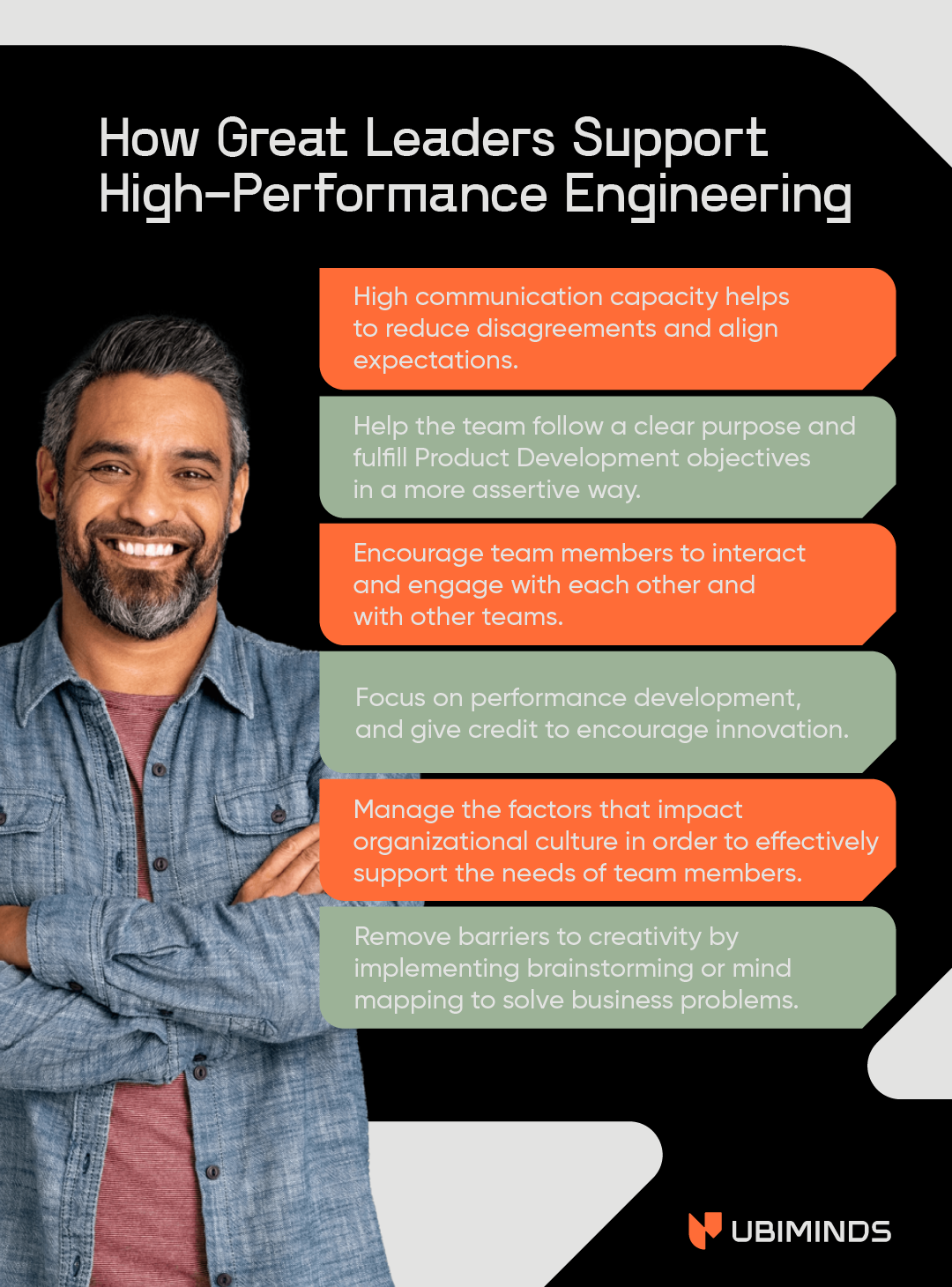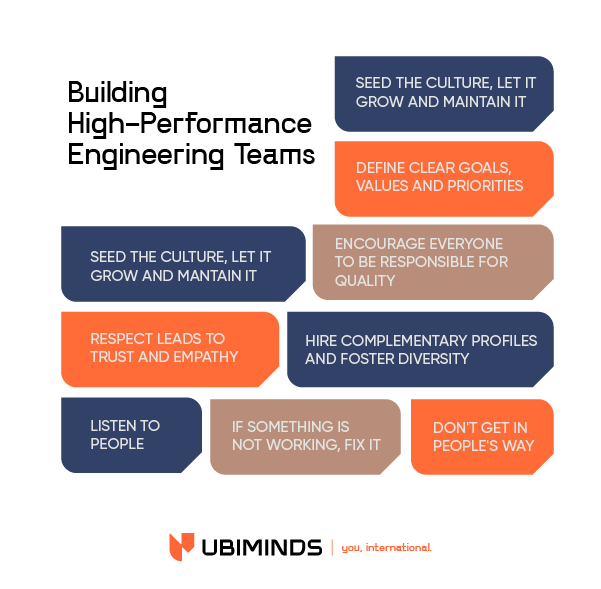A estratégia de gestão de liderança tem influência direta no Processo de Desenvolvimento de Produto e seu desempenho. Dependendo da sua metodologia, um líder pode se tornar um facilitador e mediador para sua equipe ou um controlador que atrapalha as coisas.
Então não é uma falácia dizer que os líderes e seus métodos de liderança são os principais responsáveis por construir equipes de alto desempenho. Desde o atendimento às necessidades do cliente até a viabilidade técnica e financeira, passando pelo conceito da ideia, design e teste para lançá-la no mercado, é crucial impactar a maneira como a equipe trabalha para atingir objetivos importantes.
Mas, afinal, quais são as características de uma ótima liderança que entrega resultados de alto desempenho sem sobrecarregar sua equipe?
Por que uma ótima liderança é essencial para a engenharia de software de alto desempenho?
Uma equipe de alto desempenho é um grupo que reúne membros comprometidos com o crescimento mútuo e o sucesso pessoal, o que lhes permite exceder todas as expectativas razoáveis e produzir resultados extraordinários.
Mas, essas equipes não vão a lugar nenhum sem uma ótima liderança com quem a equipe possa compartilhar uma visão comum, desenvolver cada etapa de suas atividades por meio de comunicação aberta e ter liderança compartilhada, construir confiança, permitindo a inovação a partir das diferenças individuais.
O papel do líder tem um impacto significativo nas equipes de projeto e no envolvimento da organização, o que acaba afetando a equipe e seu desempenho. A maneira como o líder planeja e gerencia o trabalho dos engenheiros, aborda as relações organizacionais e as diferenças culturais, apoiando os problemas da equipe e dando soluções são fundamentais para garantir que o projeto seja entregue com qualidade e no prazo.
Como uma ótima liderança apoia o alto desempenho de equipes de engenharia de software

Como uma ótima liderança apoia uma equipe de engenharia de software de alto desempenho
- Grandes líderes têm alta capacidade de comunicação, o que ajuda a reduzir divergências e alinhar expectativas estabelecendo indicadores justos de desempenho
- Grandes líderes ajudam a equipe a seguir um propósito claro e a cumprir os objetivos do Desenvolvimento de Produtos de forma mais assertiva
- Grandes líderes incentivam os membros da equipe a interagir e se envolver entre si e com os objetivos da empresa
- Grandes líderes têm a capacidade de se concentrar no desenvolvimento do desempenho e a capacidade de incentivar a inovação
- Grandes líderes devem saber como gerenciar os fatores que impactam a cultura organizacional para atender efetivamente às necessidades dos membros da equipe
- Grandes líderes ajudam os membros da equipe a remover as barreiras da criatividade implementando brainstorming ou mapeamento mental para desenvolver ideias para resolver problemas de negócios
Estilos de liderança
Algumas pesquisas mostram que os estilos de liderança têm uma relação direta com o desempenho da equipe. Como a liderança influencia o desempenho da equipe, as organizações devem investir no desenvolvimento de seus líderes, por vários meios, como treinamento, coaching e mentoria.
The leader patterns can be divided into two large groups, those with a focus on accomplishing tasks and others with a focus on people. Each one of these groups has its key traits which collaborate to boost high performance in software engineering teams.
The truth is that each leadership style has its place in a leader’s toolkit. Knowing which of the leadership styles works best for you is part of being a good leader. Then you can flex from one style to another as the situation demands.
Also known as managerial leadership, focuses on the role of supervision, organization, and group performance. Leaders who implement this style focus on specific tasks and use rewards and punishments to motivate followers.
How it works
Focused on completing tasks, Transactional Leadership seeks to engage team members through personal or material rewards that make members always seek to do more to achieve those rewards.
is people-focused and takes into consideration, empowerment and motivation.
How it works
Transformational leaders are charismatic, inspiring, and use intellectual stimulation and individual consideration.
In the management of traditional projects, the transformational leader has the power to influence the team, so that its performance is positively related to this style of leadership. In non-traditional project management, charismatic leadership encourages team development and improvements in deliveries to the organization.
encourages individual thinking, self-development, and leadership sharing to achieve the desired performance of the team.
How it works
It has four theoretical bases: behavioral self-management, social cognitive theory, cognitive behavior modification, and participatory goal setting. This leader divides power or provides greater responsibility and autonomy to those being led and seeks to engage team members, encouraging them at all times to become self-reliant and stimulating their development.
Key traits of strong leaders that boost high performance in software engineering teams
Software engineering teams that work in a high-performance rhythm have some key traits in common:
1. Source and hire high-level software engineers
For high-performance leaders, hiring is a process that directly impacts company revenue. That’s why it must include strategies to find candidates with a cultural fit, otherwise, the results of the team and the development of the software can be harmed. Cultural fit is also important to attract and retain the best tech talents. See how to attract and retain the top tech talent
2. Establish respect as a non-negotiable value
Respect drives trust and trust is one of the cornerstones of high performance. Let people show you how it is done. You should be a supporter not a commander who dictates how every detail should be done – this can quench their spirit. Being respectful and listening to people will capture their empathy, sending the message that you’re a reliable leader, making the virtuous circle spin.
3. Define clear goals, values, and priorities
Setting realistic goals based on your human resources, deadlines, and company expectations also is a trait of high-performance leaders. To achieve that, set clear values, priorities, and responsibilities and leave the people free to be innovative.
4. Seed The Culture, Let It Evolve, and Maintain It
People, process, and culture. This tripod defines a compelling direction for any Product or Software Team. Developing a strong culture based on trust and confidence is extremely important because it creates the trigger which connects technical skills and the company’s goal. Without it, he says, motivation goes down.
Read How to structure a distributed software development team that has high performance

Nine elements to build high-performance engineering teams. Inspired by CoderHood
5. Encourage everyone to be responsible for quality
Quality is not just QA’s responsibility. Quality is everyone’s responsibility: Developers, quality engineers, agile coaches, project managers, people managers, product owners, designers, and executives. Everyone needs to be concerned and focus on creating high-quality products. The responsibility of QA is to catch and verify missed issues, not to enforce quality. Quality Assurance More is there to help the process of creating quality results, not to block the team from shipping software.
Extra (final) tips for High-Performance Leadership:
- Keep the Communication Bar High: The low-performing groups have more communication than the high-performing groups, but it is not the quantity of the communication but the quality that is important in determining performance. So, always remember to communicate the rules of engagement and team member responsibilities to ensure open dialogue and exchange of ideas. This participatory approach will minimize the risks of innovation while maintaining progress and harmony in the workplace.
- Lead others by a vision: Because of a lack of purpose, thousands of talents worldwide (including engineers) quit their job. 72% of these professionals consider vision as the second-highest most important requirement for a leader, according to Harvard Business Review.That percentage increased to 88% of respondents who held more senior roles. Vision is crucial.
- Align clear expectations, never abstract: As early you set expectations of your team, the better they’ll know the structure and the work dynamics. The easier is the guidelines, the less trouble to track it and respond to the data. You know you have nailed it when the team starts holding each other accountable to the performance guidelines. Be transparent and keep the team’s output predictable & valuable.
- Don’t be in people’s way: Always involve all stakeholders and never concentrate information and knowledge: instead, distribute it whenever possible. Mistakes are part of the learning process (the most important is always fixing what is not working). Of course, the more mature your team is, the fewer mistakes will happen, so Encourage Continuous Learning is a good practice.
Read People Management and How to keep your software engineers at the top of their game
It’s about more than roles: the importance of promoting Situational Leadership
A Situational Leader is a Leadership model that provides the leader a couple of the best practices (what and how to do) and strategies to act in every situation they face. It’s similar to a script of task behavior and relationship behavior and helps a lot when building your responses:
Objective
Is a short-term approach intended to create movement in insecure or unmotivated people
Application
Apply questions such as ‘Do you have any questions on the instructions we’ve just reviewed?’
Objective
Is intended to create buy-in and understanding for individuals who are more able to do the task.
Application
Define the roles and tasks of the followers, and supervise them closely. Also actively recognize the enthusiasm, interest, and commitment of the follower.
Objective
To create alignment with followers who are experienced and able to do the task but lack the confidence or the willingness to take on responsibility.
Application
Concentre-se menos nas tarefas atribuídas e mais nos relacionamentos entre o seguidor, o líder e o grupo.
Objetivo
para criar/melhorar o domínio da tarefa e a autonomia no seguidor.
Aplicativo
Delegue tarefas ao seguidor e observe com o mínimo de acompanhamento. Possível pergunta: ‘Da sua perspectiva, o que está funcionando e o que precisamos considerar fazer diferente daqui para frente?’
A Ubiminds combina o melhor de cada mundo quando se trata de fazer seu negócio de software crescer. A Ubiminds também oferece suporte à Gestão de Pessoas na equipe de engenheiros de software, atuando como uma agência boutique para preencher posições de Principal e Lead (bem como outras funções de liderança), mas tem um modelo de engajamento facilitado para que você possa aumentar e diminuir a escala das equipes rapidamente. Quer saber mais? Vamos conversar!

International Marketing Leader, specialized in tech. Proud to have built marketing and business generation structures for some of the fastest-growing SaaS companies on both sides of the Atlantic (UK, DACH, Iberia, LatAm, and NorthAm). Big fan of motherhood, world music, marketing, and backpacking. A little bit nerdy too!


